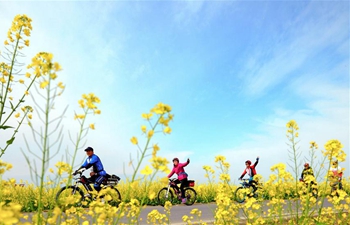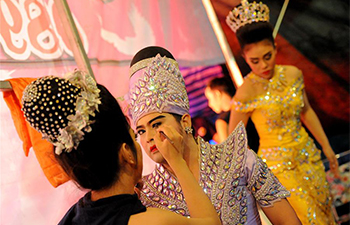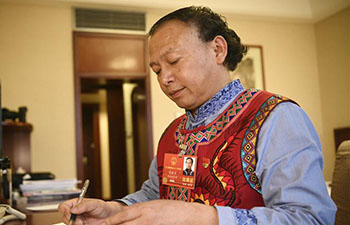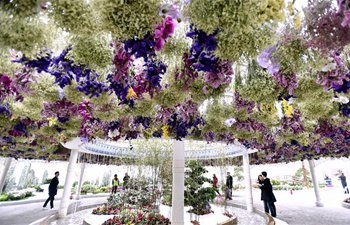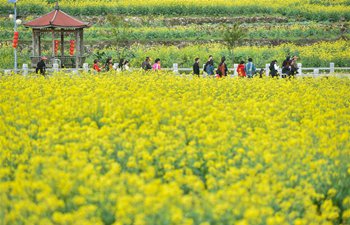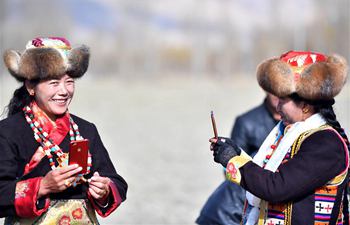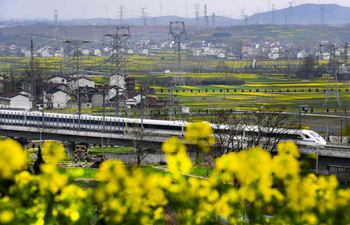by Xinhua writer Ye Zaiqi
SAN FRANCISCO, March 17 (Xinhua) -- A dozen American high school students posed merrily for a group photo, each holding a painting or drawing to which they put a final touch minutes ago Saturday in a contest on Chinese language and arts in the western U.S. state of California.
The students, from Justin-Siena High School in Napa city of northern California, joined their peers of other schools from various places of San Francisco on the country's west coast for the annual 14th Chinese Language Bridge Cup Contest, which opened here for a two-day event.
Shelby Thomason, an 11th-grade girl from the high school, completed a piece of oil painting of a tree in leafy profusion in the two-hour contest, which she said represented hopes and life for everyone on the planet.
Thomason said she has studied Chinese language for three years and it is a great fun to attend the contest that has drawn over 1,100 children ranging from kindergarten kids to high schoolers from across San Francisco and its neighboring cities and counties.
"I think it's really cool that people from all over California, not just for people like a Chinese background, can come and participate in these kinds of things," she said after the contest.
"Before I took Chinese in high school, I didn't have any idea about the culture or like writing or drawing or anything like arts, it's not really my thing, but it's fun to come for the contest that incorporates different ideas and show what you've learned in school and be a little artistic," said the girl explaining how she started to learn Chinese.
She said it was a bit weird and hard for her to learn Chinese at the beginning because it was the most difficult language in the world.
However, she said the writing of Chinese characters is a form of art, which made her feel different.
An active volleyball player at her school, Thomason said, "While learning Mandarin (standard Chinese), you can do arts and writing, because writing is kind of artistic form and I like that and this contest. It's kind of being fun for me to see different aspects of competition."
"It's amazing to see how unique Chinese culture is and Mandarin the language," she said, trying to explain the meaning of her beautiful Chinese name Tang Shiyu, which means "poetry amid misty rain" in the ancient Chinese Tang Dynasty from the year of 618 to 907.
Juliette Nast, a 12th-grade girl from the same school, shared her similar experience of how she learned Chinese for four years.
She said learning Chinese at the high school is a bold decision.
"I'm going to take French first but then I decided to try something new and take Mandarin," she said.
She said it was a great fun to learn Chinese, and "I have done this competition for the past three years too."
"After my sophomore year, I went to China with my teacher and a few other students. And we went to Beijing and Shanghai, and stayed with my host family and saw a lot of places in China," she recalled her trip to China, which left a very strong impression on her.
Nast said she saw lots of shared bikes on the streets in Beijing. "It's amazing and very convenient for people out there to ride them around in the city."
Nast expressed huge interest in the shared bikes, which her teacher talked about in class as one of the four new "Great Inventions" of China -- along with China's Express Railway, Alipay online payment system, and online shopping, a phenomenon that amazed the whole world as part of China's rapid rise to be the world's second largest economy.
Vivi Li, instructor of world languages of Justin-Siena High School, said one in ten of the students in her school are taking the Chinese course, and showed great passion for Chinese culture.
"It's really unusual for a Catholic school that has only about 650 students on campus in Napa, where there are much smaller Chinese communities than any other places in San Francisco," Li said.
However, she added that her students studying Chinese language expressed tremendous passion for the ongoing contest, which was jointly hosted by the Confucius Institute at San Francisco State University and San Francisco Unified School District.
The students from different language and cultural backgrounds are free to choose a seat for competition from the events ranging from Chinese calligraphy (Brush), Chinese calligraphy (Pen), drawing or painting, Chinese composition, and Chinese poetry recital.
Xie Jiaxin, director of the Confucius Institute, said the contest aims to give a platform for American and overseas Chinese kids to present their Chinese language proficiency and demonstrate their Chinese culture talents.
"We hope the contest will help boost Chinese language teaching in the United States, deepen the understanding of American young people about the Chinese language, culture and history, and create more opportunities for them to improve their bilingual language proficiency oriented toward the 21st century," Xie said.




